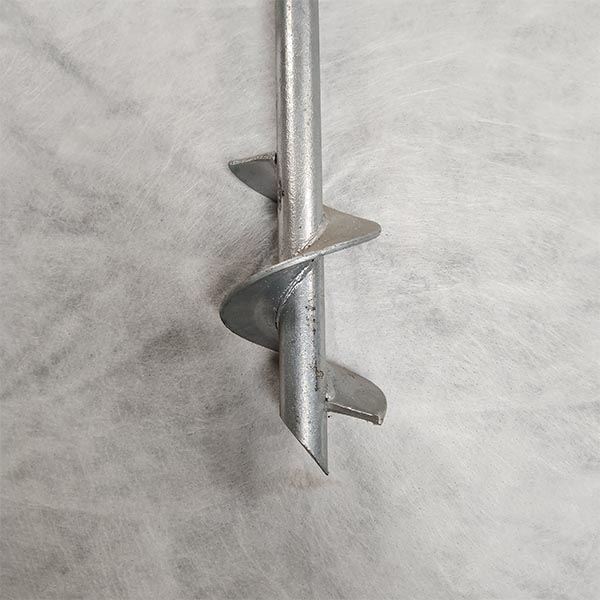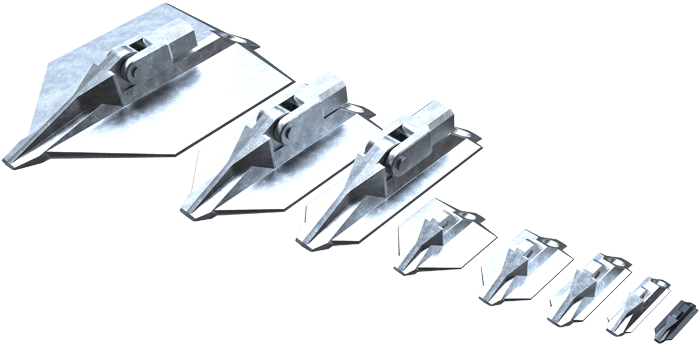Why Modern Building Site Needs construction site anchors to Prevent Foundation Failure
Wiki Article
Just How Sturdy Earth Anchors Job: A Comprehensive Overview to Soil Anchoring Solutions
Sturdy Earth supports play a vital role in supplying stability and assistance in numerous building applications. By installing deeply into the ground, they resist side and upright forces efficiently. Various kinds of supports provide to different soil problems, making them flexible. Comprehending their mechanics and setup strategies is necessary for making best use of efficiency. What aspects affect their effectiveness, and how do they compare to standard techniques? The answers may amaze you.Comprehending Heavy-Duty Earth Anchors
Durable Earth supports offer as important components in numerous building and construction and landscaping jobs, supplying stability and support in difficult soil problems. These supports function by being embedded right into the ground, where they resist side and vertical pressures. Their design enables safe and secure attachment to structures, guaranteeing they stay secured versus dirt activity or external loads.The efficiency of durable Earth supports mainly depends upon the kind of dirt and the support's setup deepness. Appropriate installment strategies are vital, as they identify the support's holding capability. Environmental variables, such as moisture and freeze-thaw cycles, can likewise affect performance.These anchors are often utilized in applications ranging from protecting fences and retaining walls to supporting short-term structures throughout damaging climate problems. Recognizing the principles behind durable Earth anchors is vital for specialists seeking to boost the resilience and security of their projects.Types of Heavy-Duty Earth Anchors
Numerous sorts of heavy-duty Earth anchors are designed to meet particular needs based on dirt conditions and job requirements. Helical supports, featuring screw-like blades, work in softer dirts, offering high lots capabilities and simple installation. Driven supports, which are inculcated the ground, appropriate for rocky terrains and provide instant load support. Tie-back supports are typically utilized in keeping wall applications, permitting for lateral assistance by securing into the ground at an angle. One more kind is the cast-in-place anchor, ideal for concrete applications, as they are incorporated into structures for enhanced security. Lastly, soil screw anchors are functional options that can be made use of in different dirt types, offering dependable tension and compression abilities. Each kind serves distinct applications, ensuring stability and safety and security in building and landscaping projects. Recognizing these choices permits informed choices in choosing the suitable Earth securing service.The Mechanics of Dirt Anchoring

Recognizing the mechanics of soil anchoring requires an assessment of numerous types of Earth supports and their installation methods. Each anchor type provides unique qualities that affect its performance in different dirt problems. Correct installment approaches are essential for taking full advantage of the securing system's security and efficiency.
Kinds Of Earth Anchors
Earth supports, essential components in dirt anchoring systems, can be found in several types, each developed for details applications and soil problems. The most typical types include screw supports, which are twisted into the ground, providing solid side resistance. Helical anchors feature blades that enable reliable installation in numerous soil types, making them ideal for both short-term and irreversible applications. Driven anchors, normally made from steel, are inculcated the dirt and are effective in rocky or thick settings. Auger supports make use of a helical design to promote setup in softer dirts. Lastly, plate supports include a level plate hidden horizontally, distributing tons over a bigger area, perfect for applications needing high lots abilities in natural soils.Installment Techniques Clarified
Appropriate installation strategies are crucial for the effectiveness of dirt anchoring systems. The process usually begins with site evaluation, validating the chosen location can sustain the anchor's tons. After identifying the appropriate support type, correct hole deepness and angle should be established. The installation includes driving the anchor into the ground using specific tools, such as hydraulic or hands-on chauffeurs, to attain best embedment. Post-installation, tensioning the anchor is crucial to ensure security; this is frequently confirmed with load testing. In addition, bordering soil problems must be kept track of to avoid variation. Following these methods not only improves the support's efficiency yet also prolongs its life-span, offering reputable assistance for numerous applications.Applications of Heavy-Duty Earth Anchors
While sturdy Earth supports are usually linked with building and construction and landscape design, their adaptability encompasses a variety of applications throughout different sectors. In civil engineering, they supply important assistance for retaining walls, guaranteeing stability in areas vulnerable to dirt disintegration. The marine industry uses these anchors for safeguarding docks and marinas, preventing activity created by currents and trends. Furthermore, in the telecom market, sturdy Earth supports are significant for supporting cell towers and other high structures against wind forces. Agricultural applications likewise profit, as these anchors can safeguard structures like greenhouses and animals secure fencing, guaranteeing they stand up to harsh climate condition. Furthermore, in renewable resource tasks, such as wind farms, Earth anchors play an important duty in safeguarding generator foundations, enhancing general safety and efficiency. This wide variety of applications highlights the flexibility and reliability of sturdy Earth anchors across different areas.Benefits Over Traditional Anchoring Approaches
Although standard anchoring methods have long been trusted for stability, sturdy Earth anchors provide considerable benefits that boost performance and efficiency. One significant benefit is their exceptional load-bearing capacity, which enables them to endure greater pressures without failure. This toughness makes them perfect for demanding applications, such as in construction and utility installations.Additionally, sturdy Earth anchors are made for much deeper installation, providing greater stability in numerous soil problems, including loosened or sandy soils. Their resistance to rust and ecological variables guarantees a longer life expectancy and decreased upkeep prices contrasted to standard methods.Moreover, these supports can be installed with marginal disturbance to the surrounding area, protecting the honesty of the landscape. In general, sturdy Earth supports present a trusted and effective solution for anchoring requirements, going beyond the limitations typically related to typical anchoring techniques.Installation Process and Best Practices
The installation process for dirt securing remedies starts with comprehensive preparation and website analysis to assure peak efficiency. Following this, a detailed installment overview gives clear guidelines for effective implementation (soil anchoring solutions). Adhering to these best practices is important for attaining durable and trustworthy anchoring outcomesPrep Work and Site Evaluation
Efficient preparation and extensive website assessment are essential steps in the installment of soil anchoring services. Before setup, the soil type have to be evaluated to determine its bearing capability and viability for anchoring. Conducting a geotechnical survey can provide vital info concerning soil composition, wetness levels, and possible ground motion. In addition, identifying existing frameworks, vegetation, and energies is vital to our website avoid interference during installation. The location ought to be removed of debris and barriers to guarantee safe gain access to for equipment. Climate condition should likewise be checked, as negative problems can impact both security and installation efficiency. By carefully preparing the site and reviewing all relevant aspects, the possibility of successful support performance is substantially increased.Step-by-Step Setup Guide
A thorough installation process is crucial for attaining optimal performance of soil securing services. The setup starts with selecting the proper anchor type and assuring the website is free from particles. Next, proper opening positioning is established based on load requirements. When the location is established, openings are pierced to the defined deepness and diameter using the proper tools. The anchor is after that inserted into the opening, making certain it is lined up appropriately. After safeguarding the anchor, soil is backfilled and compressed to improve security. It is necessary to follow producer guidelines throughout the process. A post-installation examination confirms that the anchors are appropriately located and operating as meant, providing trustworthy support for the desired application.
Maintenance and Evaluation of Earth Anchors
Normal maintenance and assessment of Earth anchors are vital for ensuring long-term performance and stability. Periodic checks allow for the early detection of concerns such as corrosion, loosening, or soil motion. Inspectors must try to find indicators of corrosion or deterioration on the anchor elements, specifically at the connection points. Additionally, the bordering dirt needs to be assessed for disintegration or modifications in wetness material, which can impact anchor effectiveness.It is suggested to develop a routine inspection i thought about this timetable, ideally at the very least when a year, relying on ecological problems. Throughout evaluations, all noticeable components need to be cleaned to eliminate dust or debris that could conceal prospective issues. Any indicators of distress, such as tilting frameworks or uncommon settling, ought to motivate immediate evaluation. Proper documents of evaluations can aid in tracking support efficiency in time and facilitate prompt upkeep actions, making certain the supports continue to be useful and trusted.Regularly Asked Questions
What Materials Are Heavy-Duty Earth Anchors Generally Made From?
Heavy-duty Earth supports are generally built from resilient materials such as galvanized steel or stainless steel, making certain toughness and resistance to deterioration. These products give lasting assistance and stability in different soil problems and applications.How Do Soil Conditions Impact Support Efficiency?
Soil conditions considerably affect anchor performance. Aspects such as dirt type, dampness material, and compaction affect the support's grasp and stability, with natural soils typically providing far better resistance than loose or sandy dirts, affecting general efficiency.
Can Heavy-Duty Earth Anchors Be Recycled After Removal?
Sturdy Earth supports can be recycled after elimination, supplied they are examined for damage and wear. Correct cleansing and upkeep boost their long life, ensuring effective efficiency in succeeding installments when problems enable risk-free reinstallation.What Are the Ecological Impacts of Using Earth Anchors?
The ecological impacts of making use of Earth supports include potential dirt disruption, disturbance of local ecosystems, and feasible contamination of groundwater. If utilized properly, their advantages usually surpass these problems, promoting stability in different applications.Exactly how Do I Choose the Right Support for My Job?

Report this wiki page